The Department of Environmental Conservation (DEC) has released a draft Essex Chain Complex Unit Management Plan. This draft UMP seeks to manage public recreational use of the newly purchased and classified 12,000-acre Essex Chain Lakes and Pine Lake Primitive Areas of the Forest Preserve in association with the adjacent Wild Forest, Wilderness and conservation easement lands. These new Forest Preserve acquisitions around the Essex Chain Lakes and Pine Lake create dynamic new recreational opportunities, yet pose a variety of management challenges.
Protect the Adirondacks supports some elements of the proposed draft Essex Chain Complex Unit Management Plan (ECCUMP), but is troubled by many others. The ECCUMP includes many novel proposals, such as extensive public motorized uses in designated “Scenic River” and “Wild River” corridors, backcountry campsites reserved exclusively for float plane users, a new formal backcountry permit reservation system, a public road and parking area near the heart of the Essex Chain Lakes for public motor vehicle use, among other actions.
PROTECT believes that all actions in a draft UMP should comply with the SLMP and other state laws and regulations, such as the Wild, Scenic and Recreational Rivers Act (Rivers Act). In such cases where the DEC is proposing action that requires changes to either the SLMP or other state laws, DEC should list these as options if laws are changed in the future. PROTECT’s review of the ECCUMP finds many proposed actions in violation of these laws and regulations.
The ECCUMP also appears to be a barebones draft Unit Management Plan (UMP) that does not include many of the standard analyses and inventories of natural resources, lists of areas in need of rehabilitation, assessments of public uses, among other required information enumerated in the Adirondack Park State Land Master Plan’s (SLMP) Unit Management Plan Development section. PROTECT believes that recent approved UMPs saw the DEC develop a standard set of information and appendices that should be included in this UMP as well.
The DEC is taking public comments on this UMP until July 25, 2014. See more information at the DEC website.
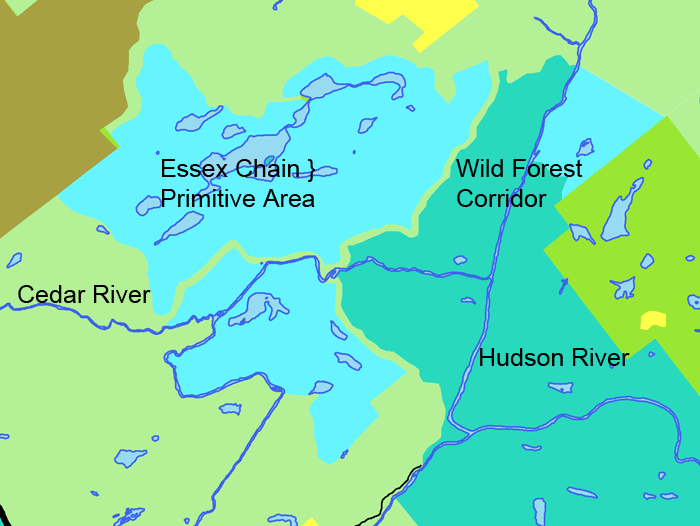
This map shows the Essex Chain Primitive area and surrounding Wild Forest and Wilderness areas. Note the Wild Forest corridor.
Major Issues in the Draft Essex Chain Complex UMP
Compliance with the Wild, Scenic and Recreational Rivers Act: The ECCUMP includes four proposed actions that violate the Wild, Scenic and Recreational Rivers Act (Rivers Act). These include:
1. The DEC’s proposal to maintain the Chain Lakes Road South as a public motor vehicle route to a point north of the former Outer Gooley Club buildings violates the Rivers Act. For nearly one-half mile this road is within the Wild River corridor, which prohibits motor vehicle use and is supposed to be managed as Wilderness lands. This road should be closed and parking area to provide canoe access to the Hudson River built at a point outside outside the Wild Rivers corridor. The DEC claims that the DEC Commissioner can somehow make a determination that it can authorize public motor vehicle use in a Wild River corridor, but PROTECT finds no such authority granted in the law.
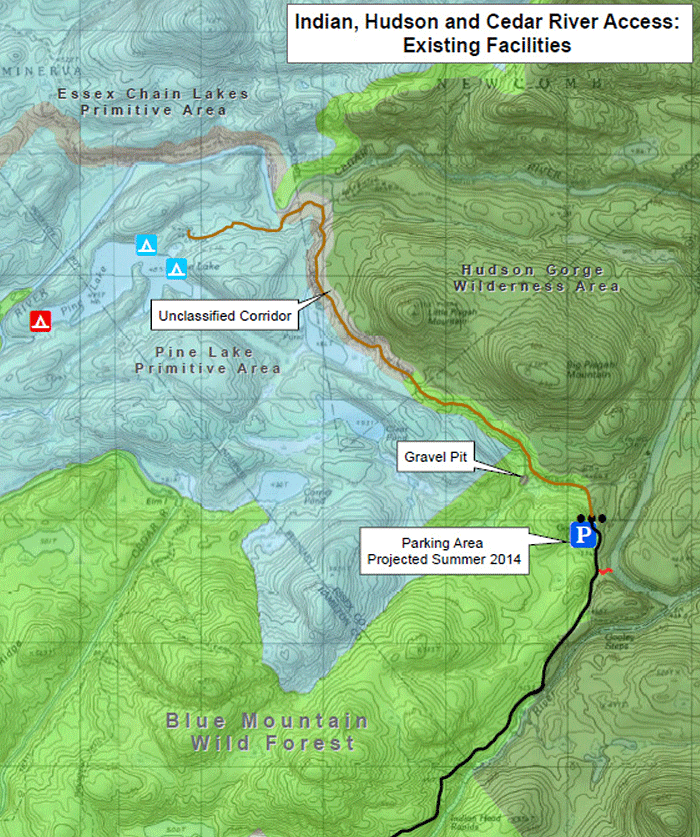
The DEC proposes to maintain a public motor vehicle road, and build a parking area, within the Wild River corridor, which violates the Wild, Scenic and Recreational Rivers Act. PROTECT calls upon the DEC to close the road and build the parking area at a point south, outside the Wild River corridor.
2. The proposed construction of the a new bridge over the Cedar River violates the Rivers Act. The DEC proposes to build a new, long bridge over the Hudson River. This bridge is being built ostensibly for horse-hiking-mountain bike use, but is being built of a size and scale to hold snowmobiles and groomers. Motor vehicle use on such a bridge would violate the Rivers Act. Moreover, DEC regulations for the Rivers Act define a trail as 4 feet in width.
PROTECT also notes that when the DEC moved the proposed location of this bridge, it appears it was moved out of the Wild Forest corridor and into the Wilderness area.
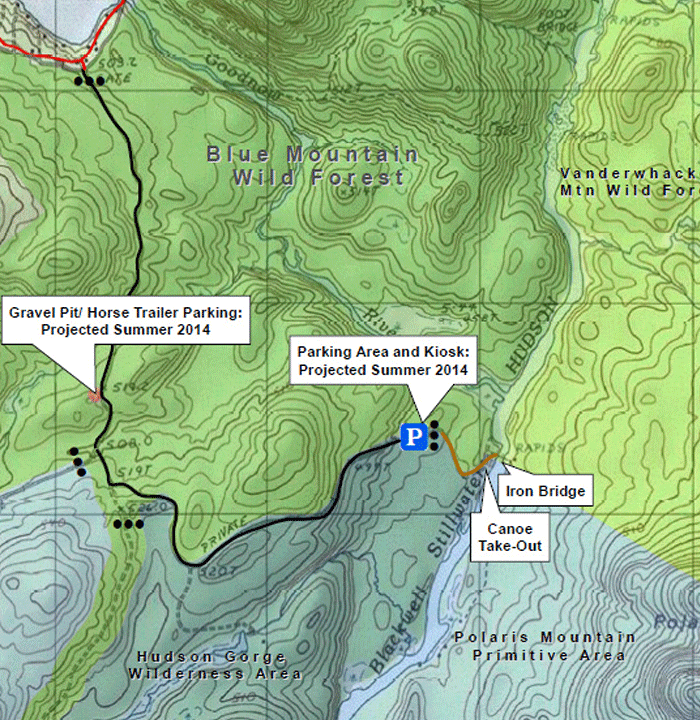
DEC proposes to keep the Polaris bridge. PROTECT believes this violates the Wild, Scenic and Recreational Rivers Act, DEC regulations, and the State Land Master Plan. This bridge should be removed and the river corridor restored, PROTECT supports canoe access/parking area to the Hudson River.
3. The DEC proposes to retain the Polaris bridge (Iron bridge) over the Hudson River. The retention of this bridge violates the Rivers Act. This bridge exists in a Scenic River corridor and as such motor vehicle use is not allowed. The bridge violates trail width standards in the Rivers Act regulations.
4. Floatplane use on Pine Lake is within the Scenic River Corridor. A large amount of the Pine Lake area is within the Scenic River corridor, where public motor vehicle use is not allowed. The reserved campsite for floatplane use is also proposed to be located within this corridor. Any motoring of a floatplane to access this campsite would be in violation of the Rivers Act.
Reserved Campsites for Particular User Groups: PROTECT finds the DEC’s proposal for reserved campsites for floatplane operators/customers to be troubling. We cannot find any precedent for this in the management of other Forest Preserve units. This proposal should be rescinded.
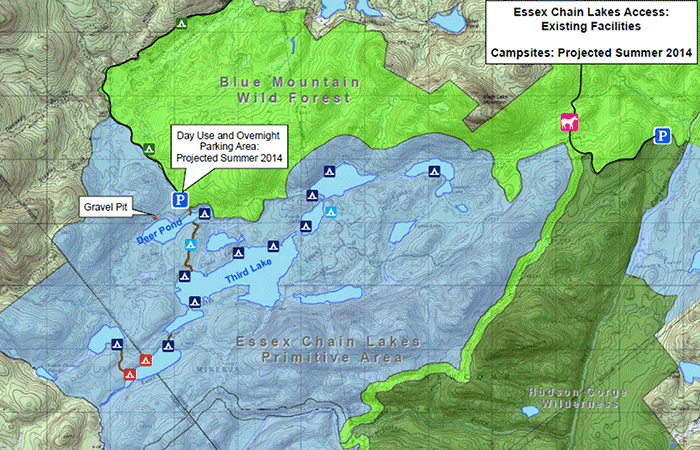
The DEC proposes to build campsites before the UMP is approved and finalized. PROTECT believes that all construction should conform with an adopted UMP and not be done beforehand. PROTECT opposes special exclusive campsites for floatplane users.
PROTECT Opposes Construction of Facilities before UMP is Finalized: The ECCUMP principally involves two Forest Preserve areas classified as Primitive under the SLMP. The “Guidelines for Management and Use” of Primitive Areas in the SLMP include Basic Guideline 6, which states “No new structures or improvements in primitive areas will be constructed except in conformity with finally adopted unit management plans. This guideline will not prevent ordinary maintenance rehabilitation or minor relocation of conforming structures or improvements or the removal of non-conforming uses.” Because public campsites and parking areas are a new use on the Essex Chain Lakes lands, PROTECT is troubled by the schedule of the DEC to site and build a number of structures and improvements, such as parking areas, campsites, canoe carries, etc., prior to the completion and formal adoption of the ECCUMP. This schedule violates the SLMP.
PROTECT notes that the DEC undertook siting and construction of campsites and other facilities at the William C. Whitney Wilderness area on an interim basis in 1998. Since that time no UMP has been drafted or finalized over the past 16 years. We hold that campsite locations would have benefited from the systematic analysis of biological conditions on the site as well as public review. Many of the campsites on Little Tupper Lake and the channel to Rock Lake are substandard and unbefitting a world class flatwater paddling area.
Campsite Reservation System: PROTECT finds the DEC’s proposal for a campsite reservation system interesting. By having it administered at the Adirondack Interpretive Center (AIC) in Newcomb on a first-come-first-served basis, with out the possibility of online advanced registration, marks a departure for how reservations are handled for campsites in Intensive Use areas in the Adirondacks.
PROTECT notes that many of our members regularly utilize the Low’s Lake, Little Tupper Lake, Round Lake, and Lake Lila areas and report no problems with overcrowding. The DEC has long employed parking lot size to limit use on these water bodies. We see no reason that this method would not successfully limit use on the Essex Chain Lakes.
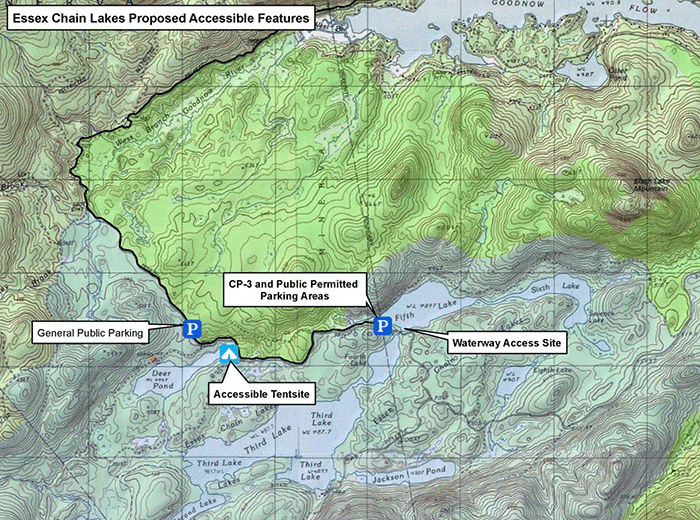
DEC proposes public access to the Essex Chain through Deer Pond and an extended permit-only drive-in access to Fifth Lake. PROTECT opposes the Fifth Lake access. PROTECT supports special access only for disabled individuals through the existing DEC CP-3 policy.
Disabled Access Facilities under CP-3: PROTECT supports road access to a CP-3 campsite on 5th Lake. The road in question forms part of the northern boundary between the Essex Chain Lakes Primitive Area and the Blue Mountain Wild Forest. PROTECT supports keeping this road open for CP-3 access only. We oppose all public motor vehicle use on this road as it will fundamentally undermine a motorless Essex Chain Lakes area.
Public Motor Vehicle Access to 5th Lake: PROTECT is troubled by DEC’s proposal to allow public use of this road and to build a new 4-car parking area for non-disabled people, which will be administered under a permit system to a point ¼ mile from the Fourth Lake-Fifth Lake culvert. This enhanced motor vehicle access to the Essex Chain is unnecessary and violates the spirit of a motorless Essex Chain Lakes area affirmed in the 2013 Forest Preserve lands classification hearing.
All public access should be limited to the Deer Pond parking area, which should be the sole point of public access to the Essex Chain Lakes. We see no wisdom in a secondary, permit system for enhanced access by the general public. That creates a troubling and dangerous precedent for Forest Preserve management.
Restoration of the Fourth Lake-Fifth Lake Channel: PROTECT calls for the culvert, known as “the tube,” between Fourth and Fifth Lakes to be removed, as well as all fill from the road approaches on both sides and the channel restored. This will allow for the natural re-vegetation of that corridor as well as establishment of a navigable channel.
Write a Public Comment Today to the Department of Environmental Conservation
Letters must be received at the DEC office by July 25, 2014:
Josh Clague, Natural Resources Planner
625 Broadway, 5th Floor
Albany, NY 12233-4254
Thank you for taking a stand in defense of the Forest Preserve.





